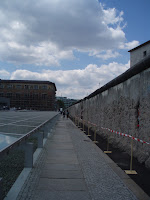The process of insulating and stuccoing the wall of the building behind mine is coming to a close: they began removing the scaffolding this morning. First they unscrew the bolts holding the scaffolding to the wall, and then put a plug into the hole so that moisture doesn't enter and ruin the whole job.

Now when I look out the back window, I see only a very clean white wall...and it feels a little strange to see nothing, blankness. It almost felt like a sort of optical illusion: was I going blind? Was it really foggy out? (Not totally weird...the weather had been beastly hot, and is now like October in St. Louis. Fog would not be out of the question.) The texture lent by the scaffolding and the green gauze covering defined the space (see earlier post, The Stucco Brigade), which is now not defined at all.
The rooms of my apartment were wonderful, even in the heat of the hottest Berlin summer in 100 years. As of last night, it's quite cool and promises to be for the next several days.
 A view with the sun coming from the west (through the kitchen, probably around 8 p.m.)
A view with the sun coming from the west (through the kitchen, probably around 8 p.m.) And the view with the sun coming from the east, probably around 6:30 a.m. The days are long in Berlin in the summer, and at the end of June it was quite a challenge to avoid being awakened at 4:30 a.m. when the daylight began to enter the room and the birds (an Amsel...) insisted on singing.
And the view with the sun coming from the east, probably around 6:30 a.m. The days are long in Berlin in the summer, and at the end of June it was quite a challenge to avoid being awakened at 4:30 a.m. when the daylight began to enter the room and the birds (an Amsel...) insisted on singing. Breakfast was the easiest and best (most reliably good) meal of my days. Great bread with Quark, honey, jam, fresh fruit, and good coffee guaranteed a good start to the day.
Breakfast was the easiest and best (most reliably good) meal of my days. Great bread with Quark, honey, jam, fresh fruit, and good coffee guaranteed a good start to the day.The quality of the food here is another topic for itself: it's amazing how much better the lettuce, fruit and other produce are, because they haven't had to travel 2000 miles to get to the store. It's something I will miss. We are getting more local in the U.S. and that's a good thing. We all benefit.
The labeling here emphasizes those benefits. They don't sell soy milk here by claiming that it's healthier. Instead they claim that it takes less energy to produce it (just grow and process the soy...not grain (using pesticide and herbicide) to feed the cattle who produce the milk). The focus here is different, just like their insistence on recycling, reusing and reducing is much more emphatic than in the U.S. And everyone takes it pretty seriously. They are not self-deceivers like we are. For example, there will be no more drilling for oil in the North Sea (announced today) until the security of the platforms is assured. Not like us, where capitalists pressure politicians to guarantee their right to make money, no matter the cost to the environment. After all, the damage in the Gulf is done, isn't it? While I'm very glad to be returning home...and home it is...I'm concerned about our blinders. And having time away makes me more acutely aware of those issues we don't discuss.
That's it for this blog. My first attempt...hopefully not the last.





















